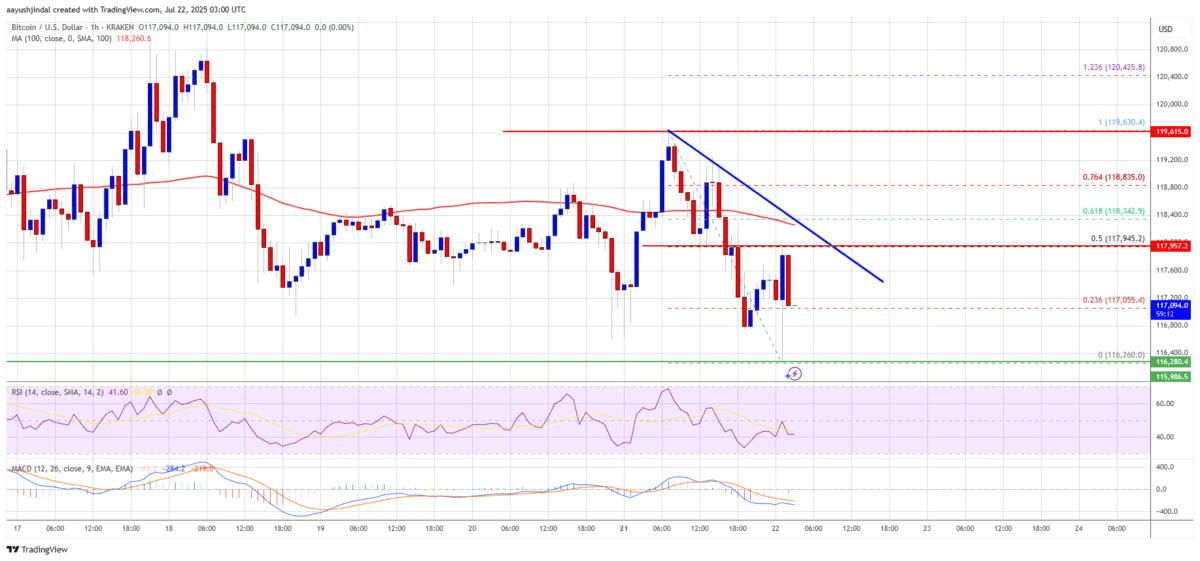On Tuesday (July 22), Asia began trading, with Bitcoin currently trading above $117,000, still maintaining a narrow range. If it breaks below the $116,200 support range, BTC may begin a downward adjustment.
Ethereum continues to stay above $3,700, approaching $3,800 on Monday, up 13% year-to-date, with analysts noting signs of a reversal after months of weakness.
Bitcoin falls again
After bulls failed to break through the $120,000 resistance, Bitcoin's price began to pull back. BTC fell below the $118,000 level and tested the $116,200 range.
Prices formed a low at $116,260 and are currently trying to rebound again. Bulls are pushing the price above the $117,000 resistance, approaching the 50% Fibonacci retracement level of the drop from the high of $119,630 to the low of $116,260.
Currently, Bitcoin's trading price is below $118,500 and the 100-hour simple moving average. Immediate resistance to the upside is around $118,000. A bearish trend line has also formed on the BTC/USD hourly chart, with resistance also around $118,000.
The first key resistance level is around $118,400. It is close to the 61.8% Fibonacci retracement level of the drop from the high of $119,630 to the low of $116,260. The next resistance may be at $119,150. If it closes above $119,150, the price may further rise. In this scenario, the price may test the $120,500 resistance level. If there is further upward movement, it may point further to $122,000, with a major target at $123,200.
If Bitcoin fails to break through the $118,400 resistance range, it may start a new round of decline. Immediate support is around $116,200, with the first major support at $115,500. The next support is in the $115,500 range. If there is further decline, the price may soon drop to the $112,500 support. Major support is at $111,200; if it breaks below this level, Bitcoin may continue to decline.

Technical Indicators:
Hourly MACD: The MACD is currently accelerating in the bearish zone.
Hourly RSI (Relative Strength Index): The RSI for BTC/USD is currently below the 50 level.
Major support levels: $116,200; $115,500
Major resistance levels: $118,000; $120,500
Beijing's attitude is changing
According to CoinShares, the enthusiasm for investing in Bitcoin ETFs and other listed digital asset products remains significantly different between the U.S. and Hong Kong.
Last week, U.S. digital asset products attracted $4.36 billion in inflows, accounting for nearly all global inflows, while Hong Kong's cryptocurrency ETF only recorded $14.1 million in inflows.
This gap appears against the backdrop of strong demand for exchange-traded products in Hong Kong. According to the Hong Kong Stock Exchange, from July 14 to 18, net inflows into Hong Kong-listed ETFs were approximately $880 million, most of which went into equity funds tracking local stocks and industry themes, with cryptocurrencies accounting for only 1.6% of total ETF inflows.
In the U.S., even as stock ETFs recorded a net outflow of $11.75 billion and bond funds saw inflows of $5.55 billion, crypto funds continued to attract capital, setting a record.
This contrast highlights the importance of cryptocurrencies as an independent asset class in U.S. portfolios, while in Hong Kong, investors still see it as a niche asset.
However, a path that could change this landscape is emerging.
At the Consensus Hong Kong conference in February this year, Yifan He, CEO of Red Date Technology, proposed a potential regulatory scheme that would allow domestic investors to access cryptocurrencies without violating mainland crypto bans.
He stated at the meeting that the existing Qualified Domestic Institutional Investor (QDII) mechanism could be referenced. QDII has allowed some domestic investors to purchase U.S.-listed ETFs with RMB, and a similar structure could be applied to spot Bitcoin and Ethereum ETFs in Hong Kong.
In this model, domestic investors would not directly hold cryptocurrencies but gain exposure through licensed intermediaries, just like they currently trade Hong Kong or overseas stocks.
"If they have a system that allows you to buy and sell with RMB, but the funds never leave the country, then it's just another regulated investment product," he said.
Although capital controls remain a core obstacle, this proposal reflects a changing attitude in Beijing.
"I see that financial regulators are sending some signals," he said, "They are starting to talk about Bitcoin and indicating the need for more attention and research on digital assets."
This does not mean China will lift its ban on cryptocurrencies, but rather incorporate them into an approved regulatory sandbox. Such a move could significantly increase participation in Hong Kong crypto ETFs, although these ETFs still struggle to gain widespread appeal despite a good infrastructure and regulatory environment.
However, the U.S. still holds an unmatched dominant position in the flow of funds into crypto funds. But if Beijing allows access to cryptocurrencies through Hong Kong ETFs in the future, the flow of funds in the region may look very different in the coming years.

